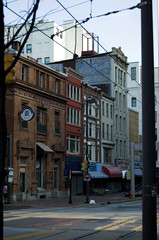The focus of Bromo Tower District’s ‘Transit’ project is Howard Street. Once a bustling corridor of large retail stores, many of buildings along Howard Street now sit vacant. Hope is strong that the newly-designated A&E District will spur neighborhood growth. Howard Street’s light rail line, a major north/south commuter option, passes by the Station North A&E District, through the campus of the Maryland Institute College of Art, and terminates adjacent to a MARC (commuter train) station at Oriole Park at Camden Yards.
Re-imagining the corridor (how it is used by riders, how it integrates into t he community, and how it is viewed by community residents and businesses), is an opportunity to mobilize urban planners, architects and artists, and engage community residents and businesses, to strategically transform the transit environment in the District. Utilizing ‘Transit’ the Bromo Tower District will create an accessible, unique, arts destination, and supply opportunities for dynamic and participatory arts experiences.
he community, and how it is viewed by community residents and businesses), is an opportunity to mobilize urban planners, architects and artists, and engage community residents and businesses, to strategically transform the transit environment in the District. Utilizing ‘Transit’ the Bromo Tower District will create an accessible, unique, arts destination, and supply opportunities for dynamic and participatory arts experiences.
With those goals in mind, in the spring of 2013 The City of Baltimore, the Bromo Tower Arts & Entertainment District and the Baltimore Office of Promotion & The Arts in collaboration with the Baltimore City Department of Transportation released a call to artist or artist team to assist with the replacement of old crosswalks within District. The goals of the project were to: install crosswalks that were distinctive and artist designed, but also compliant with traffic and safety regulations; and to improve the pedestrian experience, give better definition to downtown’s Bromo Tower Arts & Entertainment District, and add an additional public art experience in the City’s third Arts & Entertainment District.
The response to the RFP from the local arts community was extremely positive, and the District received approximately 50 complete proposals. Of course as with any project that engages the arts community, exciting and unexpected proposals are presented. This number was narrowed by a panel of community and city agency stakeholders to four designs. One for each crosswalk slated for renewal.
Once selected, the District hoped that the designs would be installed by August 2013. After all, the stakeholder group had included members of the arts community and District residents, a public art project manager, as well as officials from the lead agencies responsible for project installation. As the project began to proceed, it was soon realized that subject matter experts would also need to be engaged if the project was to move forward, including those specializing in the materials use and installation (for Thermoplast in particular) and traffic safety for pedestrians and vehicles. For all your due diligence, public projects involve a village of participants. Some you will seem obvious, others make themselves known as the project moves forward.
Additionally the initial goal of the project was to include 10crosswalks within the District. As plans moved forward, the projects total budget, which seemed robust at the outset, was consumed by costs to prepare the street for installation (an anticipated cost) and a Maintenance of Traffic cost that is associated with diverting traffic during the installation of any street construction (unanticipated). As with any public art project, be prepared to make necessary modifications to the budget, and perhaps even the projects scope.
The project moves forward, in spite of those challenges, in a more scaled version. Installation is set to conclude October 2013, in conjunction with Arts and Humanities month and will include a community event in the Bromo Tower Art & Entertainment District.


